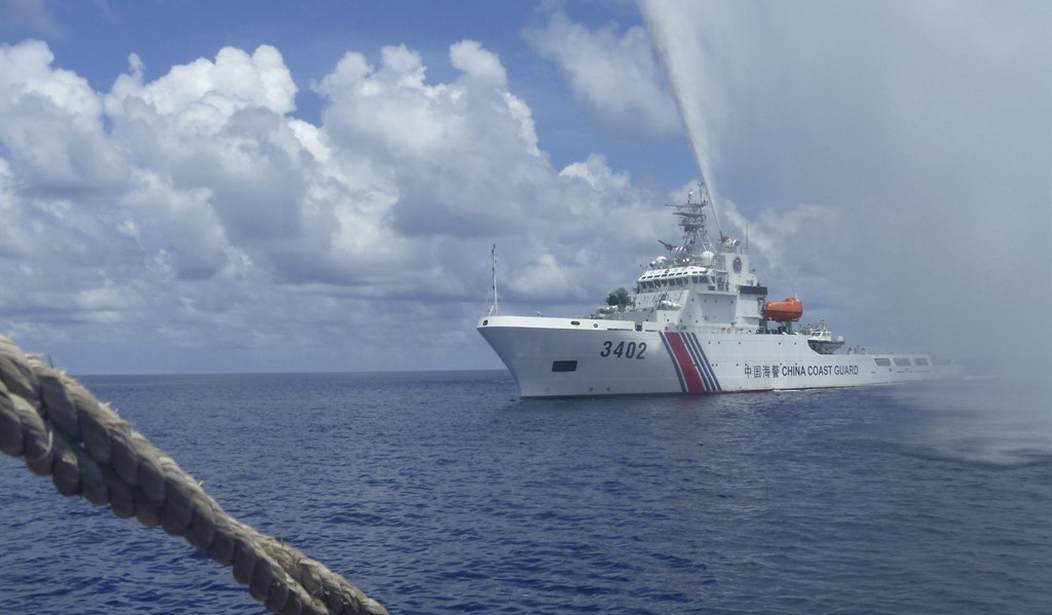Early Monday morning, Chinese Coast Guard vessels rammed into two different ships belonging to the Philippines Coast Guard leaving huge holes in the ships. The incident happened near Sabina Shoal as the Philippines' ships were on a resupply mission to Second Thomas Shoal.
In the dead of the night Monday, between the hours of 3 a.m. and 4 a.m. local time, at least three collisions occurred between coast guard ships belonging to China and the Philippines. The first tore a hole 3.6 feet in diameter on the starboard side of a Philippine coast guard vessel, the Philippines said.
About 16 minutes later, a Chinese coast guard vessel rammed another Philippine coast guard ship twice, ripping a gap 2.5 feet long and 3 feet wide on the port side, according to the Philippines...
“We can fairly say that this is the biggest structural damage we have incurred as a result of the dangerous maneuvers carried out by the Chinese coast guard,” said Jay Tarriela, a spokesman for the Philippine coast guard.
Sabina Shoal is the latest flashpoint as China makes constant efforts to expand its control over the South China Sea. Here's a helpful map. As you can see, this is a long way from mainland China.
Location of Sabina Shoal, for reference: pic.twitter.com/azZ6bik4Xh
— Nine Dragons (@ninedragons1997) August 19, 2024
China immediately blamed the Philippines for the crashes but the Philippines says there were US reporters on board one of the ships who filmed the encounter and have proof China was the aggressor.
“The Philippine side is entirely responsible for the collision,” spokesperson Gan Yu said. “We warn the Philippine side to immediately stop its infringement and provocation, otherwise it will bear all the consequences arising from that.”
Jonathan Malaya, assistant director-general of the Philippine government’s National Security Council, accused the Chinese coast guard of falsely saying the Philippine coast guard ships had rammed its vessels.
Video and photographs, including ones taken by journalists from a U.S. TV network who were on board one of the Philippine coast guard ships, showed that the Chinese ships caused the collisions, Malaya told a news forum in Manila.
I haven't seen the US video yet but China certainly has a recent history of ramming Philippine-owned boats in this part of the world. This DW clip shows some video as well as some of the damage to the Philippines' ships.
Ships from China and the Philippines collided during a confrontation near a disputed shoal in the South China Sea. pic.twitter.com/kaf6SOemGM
— DW News (@dwnews) August 20, 2024
In response to the incident, the US once again reminded China that it has a long-term mutual defense treaty with the Philippines. Had a Philippines' sailor been killed in this incident, that would be grounds for a US response.
"The United States reaffirms that Article IV of the 1951 U.S.-Philippines Mutual Defense Treaty extends to armed attacks on Philippine armed forces, public vessels, or aircraft—including those of its Coast Guard—anywhere in the South China Sea," Vedant Patel, a U.S. State Department spokesperson, said in a statement that day.
Article IV of the pact says that an attack on either country in the Pacific region would prompt the partnered countries to take action and "meet the common dangers" according to their constitutional processes.
China responded by pretending it doesn't know what the 70-year-old mutual defense treaty is.
The US is not a party to the South China Sea issue, and has no right to intervene in maritime issues between China and the Philippines, let alone use the "US-Philippines Mutual Defense Treaty" as an excuse to infringe on China's sovereignty and rights in the South China Sea, Mao… pic.twitter.com/49cNKs3puN
— Global Times (@globaltimesnews) August 20, 2024
There is a longer backstory to all of this. Earlier this year, the Philippines noticed a bunch of Chinese maritime militia and scientific vessels in the area of Sabina Shoal and sent a ship in to see what they were doing. They found evidence that China had already begun some kind of reclamation project.
In April, the Philippines sent a coast guard ship to Sabina Shoal, saying China had dialed up the presence of its maritime militia boats there. In May, the Philippines coast guard reported the presence of three Chinese research vessels at Sabina Shoal.https://t.co/YJ1ozZWMWY
— Jonathan Cheng (@JChengWSJ) August 21, 2024
Specifically, they found lots of ground up coral which had been spread in various areas near the shoal. Here's a video discussing the Philippines effort to disrupt this Chinese project. Their success in doing so may be why China has such a short fuse about this shoal.
More broadly, the Chinese are constantly trying to bully and press for more control over the South China Sea and to see how committed the US is to backing up the Philippines.
“What the PRC side looks like they are doing is to try to wear down the Philippines such that they are not able or willing to try to demonstrate an effective presence. That will give the PRC de facto control or at least a veto over the disputed waters, which they don’t yet have,” Ian Chong-Ja, a China expert at the National University of Singapore, told Breaking Defense in an email.
China is “pushing the Philippines, in a way they are not pushing Vietnam,” which lays claim to some of the waters near the latest incident, Jennifer Parker, naval expert at the Australian National University in Canberra, wrote in an email to Breaking Defense.
China acted as it did “likely as a result of the Philippines campaign to push back against China, but also to test US resolve noting the Philippines relationship with the US,” she said. “China is known to employ dangerous and aggressive manuevering as a tactic.”
So far China doesn't have a lot to show for all of this effort, but they will never stop trying to expand their territorial claims.








Join the conversation as a VIP Member